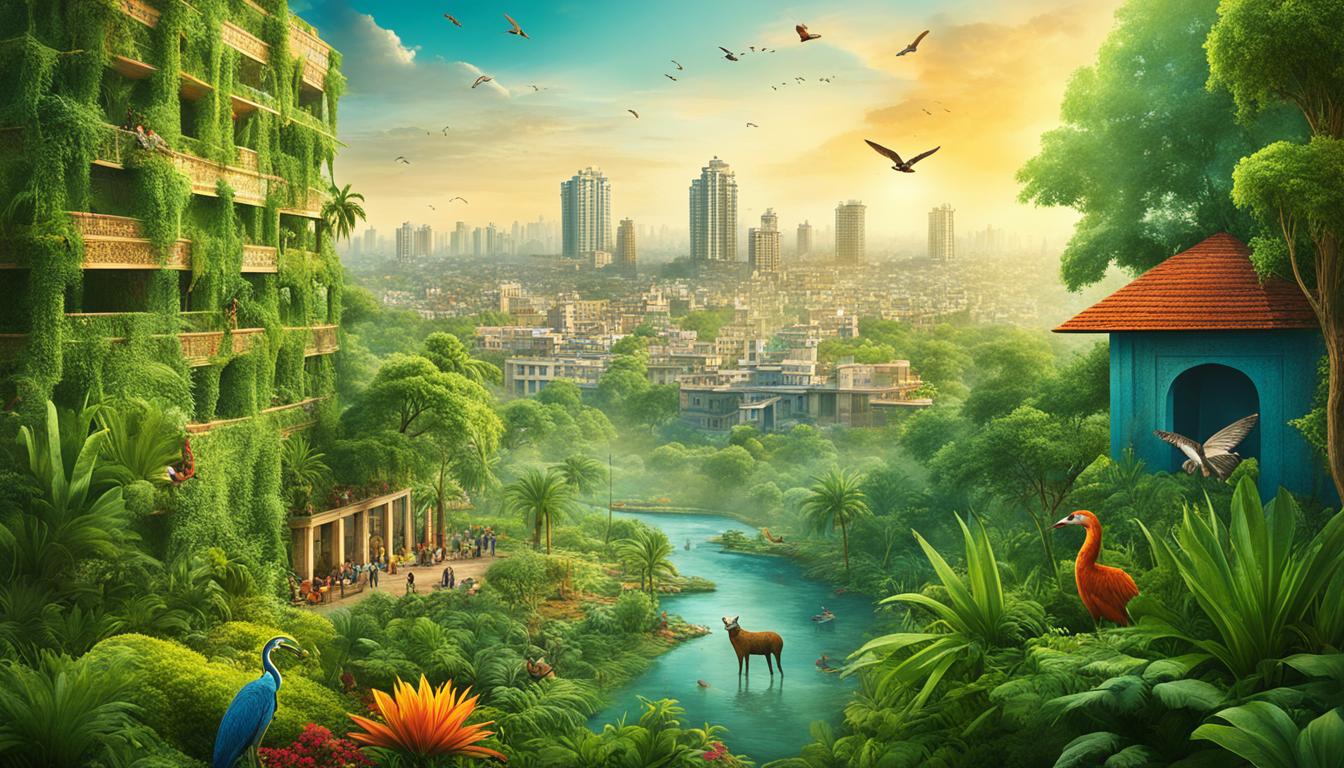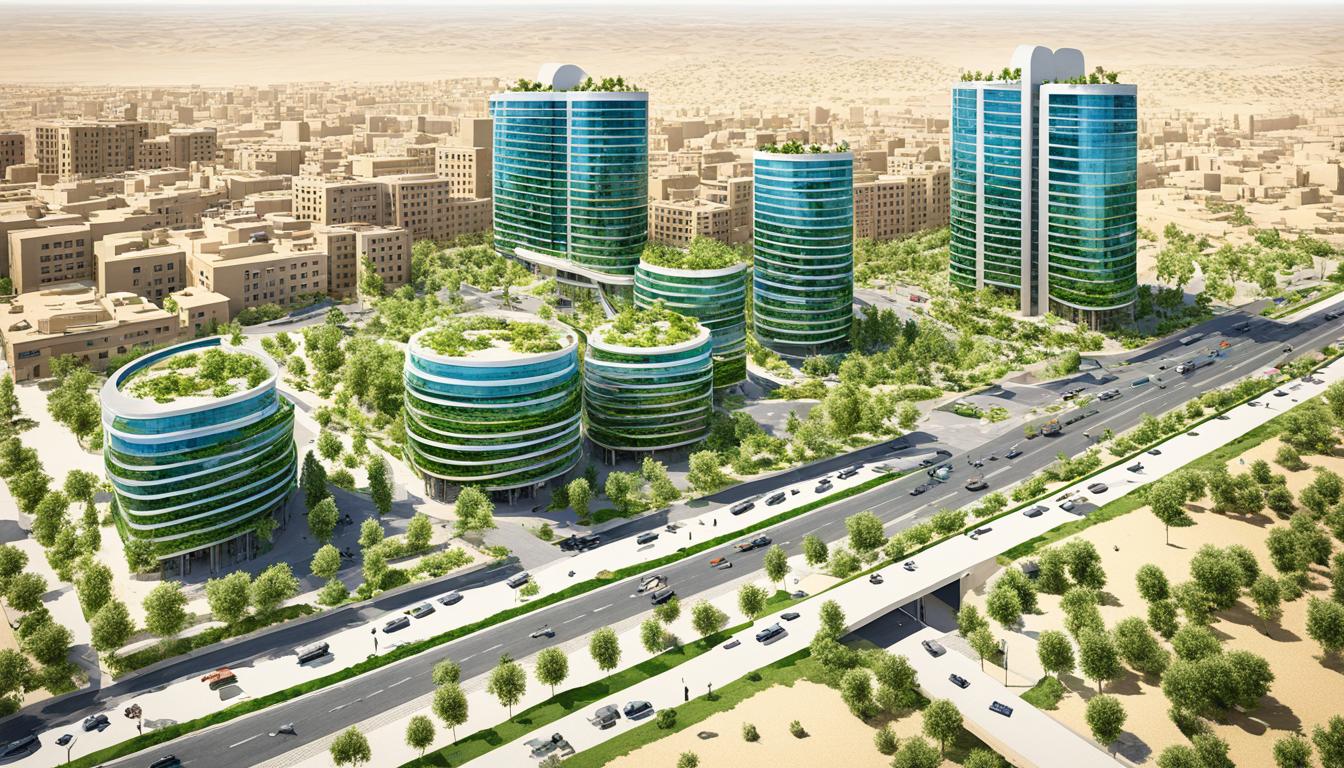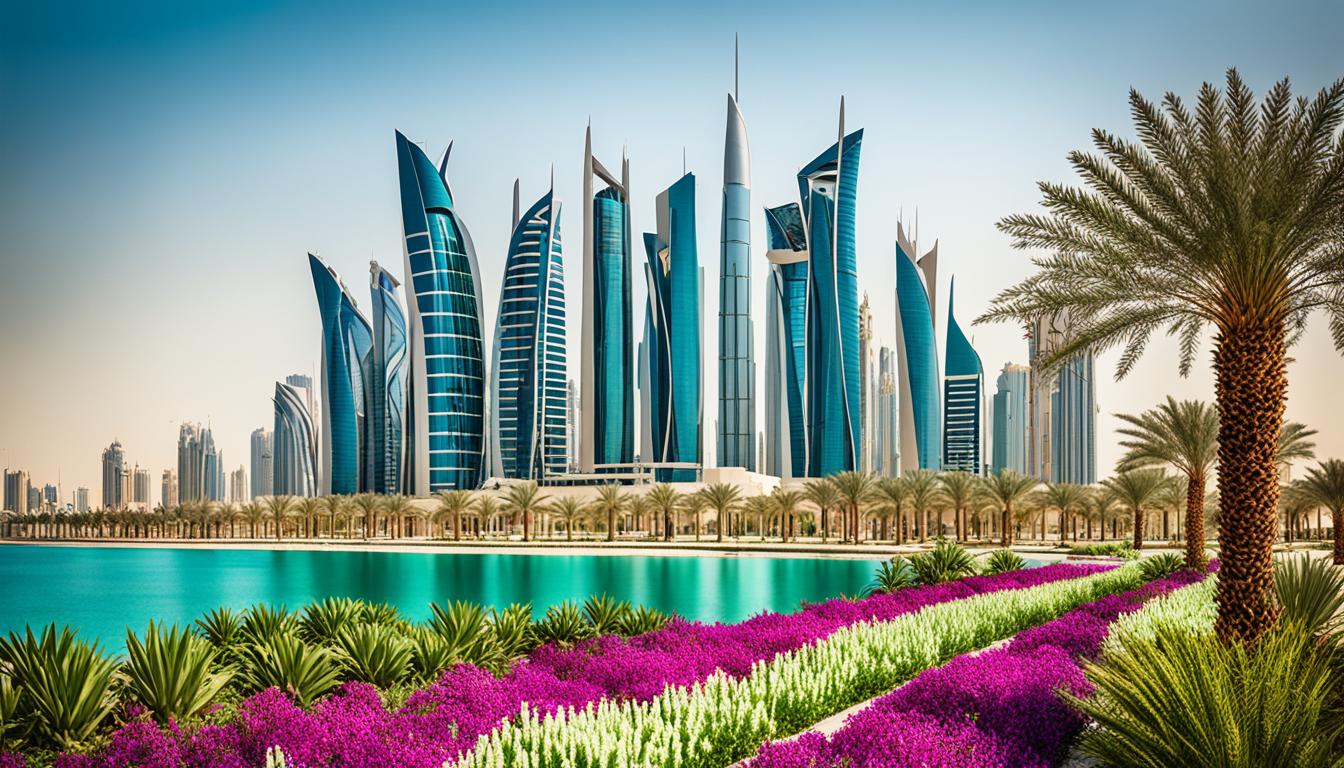Indonesia Biodiversity and the Built Environment
Did you know that Indonesia is home to over 17,000 islands, making it the largest archipelago in the world? This vast and diverse country boasts not only stunning landscapes but also an incredible array of biodiversity. However, the challenge lies in finding a balance between conservation efforts and urban development for sustainable futures in the built environment.
Key Takeaways:
- Indonesia’s biodiversity faces threats from forest utilization for national strategic projects
- Habitat restoration and legal protection are crucial for biodiversity sustainability
- Conservation efforts and community involvement play a significant role in preserving biodiversity
- Urban planning can contribute to biodiversity conservation through green infrastructure and wildlife corridors
- Green building initiatives in Indonesia promote sustainability, energy efficiency, and reduced CO2 emissions
Threats to Biodiversity in Indonesia
The utilization of forest areas for national strategic projects in Indonesia poses significant threats to biodiversity. The country ranks first in Southeast and South Asia for the number of endangered species. Habitat degradation and fragmentation are major factors contributing to the extinction of various species of biodiversity in Indonesia. The direction of development policy in Indonesia, including the legalization of forest areas utilization for national strategic projects, raises concerns about the sustainability of biodiversity and forest governance.
Indonesia’s rich biodiversity is under threat due to the utilization of forest areas for national strategic projects. As the country ranks first in Southeast and South Asia for the number of endangered species, it is crucial to address the challenges posed by forest utilization and safeguard the sustainability of biodiversity and the built environment.
Habitat degradation and fragmentation are key factors contributing to the extinction of biodiversity species in Indonesia. These destructive actions disrupt and destroy ecosystems, resulting in the loss of unique and endangered species. The conversion of forest areas for national strategic projects further exacerbates the threats to biodiversity, raising concerns about the long-term sustainability of these species and the proper governance of forest resources.
The Extinction Crisis
“The direction of development policy in Indonesia, including the legalization of forest areas utilization for national strategic projects, raises concerns about the sustainability of biodiversity and forest governance.”
This alarming situation calls for urgent action to protect Indonesia’s biodiversity and ensure the sustainable development of the built environment. It is crucial to strike a balance between economic growth and environmental conservation by implementing robust measures and sustainable practices.
The impact of forest utilization for national strategic projects can lead to irreversible damage to vital habitats and ecosystems. This loss of biodiversity not only affects the natural heritage of Indonesia but also has far-reaching consequences for global ecological stability and the overall well-being of our planet.
By acknowledging the threats and challenges posed by forest utilization in national strategic projects, Indonesia can take proactive steps to safeguard its unique biodiversity and implement effective governance measures.
| Threats to Biodiversity | Impact |
|---|---|
| Habitat degradation and fragmentation | Loss of unique species and ecosystems |
| Forest utilization for national strategic projects | Imbalance between economic growth and conservation |
| Legalization of forest areas utilization | Potential long-term effects on biodiversity and forest governance |
The table above highlights the various threats to biodiversity in Indonesia and their significant impacts. It emphasizes the urgency for sustainable practices and robust governance to mitigate these threats and ensure the preservation of Indonesia’s rich biodiversity for future generations.
Through concerted efforts and sustainable development approaches, Indonesia can successfully navigate the challenges posed by forest utilization in national strategic projects while preserving its remarkable biodiversity and contributing to a greener and more sustainable future.
Conservation Efforts for Biodiversity
To counter the threats to biodiversity, Indonesia has implemented various conservation efforts. Habitat restoration plays a crucial role in preserving biodiversity and ensuring the sustainability of ecosystems. Nature conservation initiatives aim to protect and restore important habitats for endangered species. These efforts include the establishment of protected areas, the implementation of conservation plans, and the involvement of local communities in biodiversity conservation.
The significance of habitat restoration
Habitat restoration is a key strategy in preserving biodiversity and maintaining the delicate balance of ecosystems. It involves the rehabilitation of degraded or destroyed habitats to their original state, providing a safe haven for threatened and endangered species. Restoration efforts focus on recreating the necessary conditions for diverse flora and fauna to thrive, promoting biodiversity sustainability.
“Habitat restoration is like giving a second chance to ecosystems and the species that depend on them. It is crucial for the long-term survival of our biodiversity,” says Dr. Ananda, a leading environmental scientist in Indonesia.
Protecting and restoring important habitats
Nature conservation initiatives in Indonesia prioritize the protection and restoration of key habitats that are vital for biodiversity. Through the establishment of protected areas, such as national parks, wildlife reserves, and marine protected areas, critical habitats are safeguarded from further degradation or destruction. These protected areas also serve as refuge for endangered species and promote the recovery of ecosystems.
In addition to protected areas, conservation plans are put in place to ensure the sustainable management of habitats. These plans involve the identification and monitoring of key species and habitats, implementing measures to mitigate threats, and promoting sustainable practices within these areas. By actively managing and conserving important habitats, biodiversity sustainability is prioritized.
Engaging local communities
Conservation efforts in Indonesia recognize the importance of engaging local communities in biodiversity conservation. Collaborative approaches involve local communities in decision-making processes, establishing partnerships to promote sustainable resource management and conservation practices. This community involvement not only fosters a sense of ownership and stewardship but also ensures the long-term success and sustainability of conservation efforts.
Empowering local communities through education and capacity-building initiatives further strengthens their role in biodiversity conservation. By raising awareness and providing training in sustainable resource management, communities become active participants in protecting and restoring habitats, contributing to the overall biodiversity sustainability of the region.
The synergy of conservation efforts
Through the combination of habitat restoration, protected areas, conservation plans, and community engagement, Indonesia’s conservation efforts create a synergistic approach towards biodiversity sustainability. These comprehensive strategies address the root causes of biodiversity loss, protect critical habitats, and involve local stakeholders, ensuring the long-term viability of ecosystems and the species that depend on them.
Conservation efforts in Indonesia serve as an example for other regions facing similar challenges in balancing development and biodiversity conservation. By prioritizing habitat restoration, nature conservation, and biodiversity sustainability, Indonesia is paving the way for a more harmonious coexistence between humans and nature.
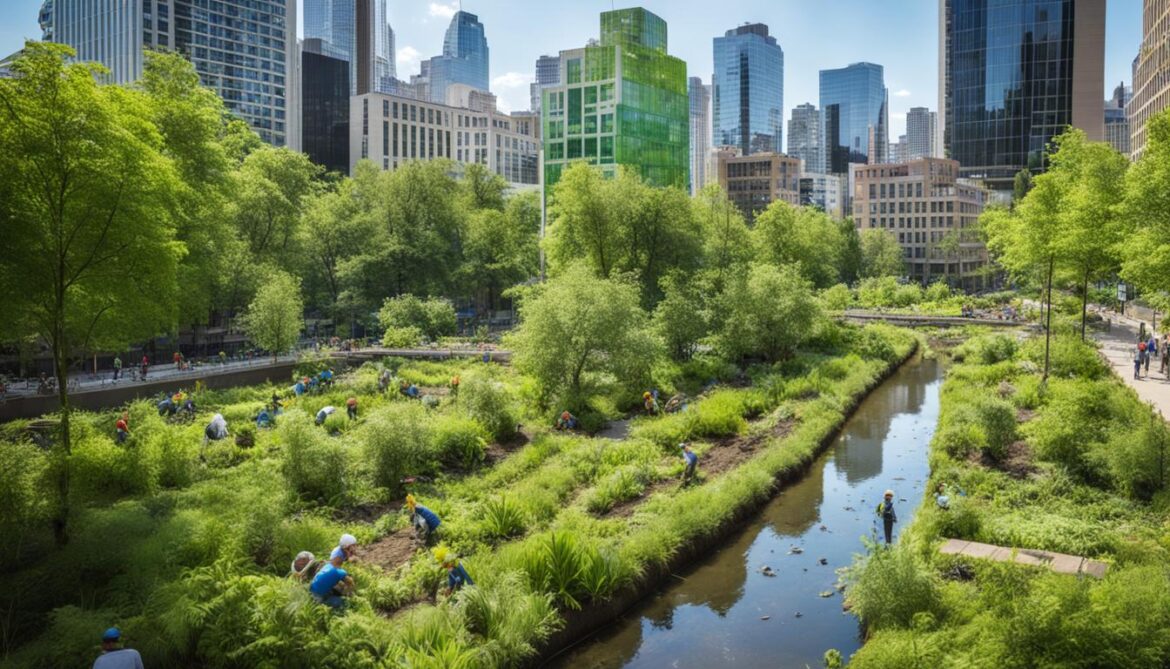
Role of Urban Planning in Biodiversity Conservation
Urban planning plays a vital role in balancing biodiversity conservation with urban development. By incorporating biodiversity-friendly design principles into urban planning, cities can create sustainable and resilient environments that support both human needs and the preservation of biodiversity.
One of the key strategies in urban planning for biodiversity management is the implementation of green infrastructure. This involves integrating natural elements such as parks, gardens, and green roofs into the urban landscape. Green infrastructure provides habitats for wildlife, promotes biodiversity, and enhances the quality of life for urban residents.
Another important aspect of urban planning for biodiversity is the creation of wildlife corridors. These are pathways that connect fragmented natural areas within cities, allowing animals to move between habitats and ensuring the continuity of ecological processes.
Moreover, incorporating green spaces within urban areas is crucial for urban biodiversity conservation. Parks, gardens, and tree-lined streets not only provide habitats for plants and animals but also offer recreational spaces for residents to connect with nature.
Environmental impact assessments are essential in evaluating the potential impacts of urban development on biodiversity. By conducting thorough assessments, planners can identify potential threats to biodiversity and implement appropriate mitigation measures to minimize harm.
Here is an example of what a table on urban biodiversity management could look like:
| Strategies | Benefits |
|---|---|
| Green infrastructure |
|
| Wildlife corridors |
|
| Green spaces |
|
By incorporating these strategies into urban planning, cities can create sustainable and biodiverse environments that benefit both humans and the natural world.
Indonesia’s Ecological Diversity
Indonesia is renowned for its remarkable ecological diversity, showcasing a wide range of flora and fauna species. With its unique geology and diverse ecosystems, the country harbors a wealth of biodiversity. Let’s take a closer look at Indonesia’s impressive species richness:
Flora and Fauna Species in Indonesia
| Species | Number of Species |
|---|---|
| Mammals | 720 |
| Birds | 1,605 |
| Amphibians | 385 |
| Reptiles | 723 |
| Freshwater Fish | 1,248 |
The level of endemism in Indonesia is exceptionally high due to its geological uniqueness. Many species can only be found within the country’s borders, making Indonesia a true biodiversity hotspot.
Diversity of Flora Species
The richness of Indonesia’s flora species is equally impressive. This includes a variety of plant groups, such as algae, spore plants, ferns, and seed plants. The endemism rates for flora species typically range between 40-50% on most islands, further highlighting the country’s botanical uniqueness.
Indonesia’s ecological diversity serves as a testament to the country’s commitment to preserving its natural heritage. By protecting and conserving the genetic diversity within its ecosystems, Indonesia ensures the long-term viability of its biodiversity.

Challenges in Sustainable Development
Sustainable development in Indonesia faces significant challenges due to the adverse effects of climate change and increasing environmental impacts. The country is prone to natural disasters such as cyclones, floods, landslides, droughts, and earthquakes, which pose significant threats to the progress of sustainable development. Balancing the needs of economic growth with environmental sustainability is a key challenge that requires strategic planning and innovative solutions.
Climate change exacerbates these challenges, causing more frequent and intense extreme weather events and unpredictable changes in temperature and precipitation patterns. These phenomena have far-reaching effects on biodiversity, ecosystems, and the overall well-being of communities.
“The impacts of climate change on the environment and society are undeniable. We must act now to address these challenges and ensure a sustainable future for generations to come.” – Dr. Maya El Haddad, Environmental Scientist
Threats to Biodiversity and Ecosystems
Climate change and increasing environmental impacts in Indonesia have severe consequences for biodiversity and ecosystems. Rising temperatures, changing rainfall patterns, and sea-level rise directly impact the habitats of various plant and animal species. This disruption threatens the delicate balance of ecosystems and poses a risk of species extinction.
The loss of biodiversity not only impacts the natural environment but also has ripple effects on the livelihoods and well-being of local communities dependent on natural resources. It is essential to protect and restore habitats, promote sustainable practices, and raise awareness about the importance of biodiversity conservation.
Building Resilience and Promoting Sustainable Practices
The Indonesian government, in collaboration with international organizations and stakeholders, is actively working to address the challenges posed by climate change and environmental impacts. Efforts are underway to strengthen resilience and promote sustainable practices across various sectors.
One key strategy is the integration of climate change adaptation and mitigation measures into national policies and development plans. This includes initiatives to reduce greenhouse gas emissions, promote renewable energy sources, and improve natural resource management.
“Sustainable development requires a holistic approach that considers social, economic, and environmental factors. By adopting sustainable practices, we can mitigate the impacts of climate change and build a more resilient future.” – Dr. Indra Adnan, Environmental Economist
Collaboration between government, communities, and businesses is crucial in implementing sustainable solutions. This includes the promotion of sustainable agriculture, forest management, and smart urban planning. Encouraging the use of clean technologies, reducing waste and pollution, and enhancing the resilience of critical infrastructure are also essential components of sustainable development in the face of climate change.
The Nexus of Climate Change, Biodiversity, and the Built Environment
Climate change and environmental impacts are closely interconnected with biodiversity and the built environment. The preservation of biodiversity is essential for maintaining healthy ecosystems, which provide numerous benefits to human society, including clean air and water, climate regulation, and natural resources.
Integrating biodiversity considerations into urban planning and development can help foster sustainable cities that are resilient to climate change. By incorporating green spaces, preserving natural habitats, and implementing nature-based solutions, such as the creation of urban parks and green infrastructure, we can enhance biodiversity and create more livable and sustainable communities.

Green Building Initiatives
Indonesia has taken significant steps towards promoting green buildings and sustainable architecture. With over 25 million square meters of certified green buildings, the country is showcasing its commitment to environmentally friendly construction practices.
Jakarta and Bandung, two major cities in Indonesia, have implemented green building codes to ensure compliance and encourage sustainable development. These codes have led to numerous buildings adopting green practices and contributing to a more sustainable built environment.
One of the programs leading the way is the GREENSHIP program by the Green Building Council Indonesia. Through this certification program, buildings are evaluated and certified based on their adherence to sustainability and energy efficiency standards. This ensures that green buildings in Indonesia meet the highest environmental performance criteria.
The Indonesian government has also played a crucial role in promoting green building initiatives. It has provided incentives to encourage the development of green buildings, creating a favorable environment for sustainable construction practices to thrive. By offering support and incentives, the government is actively driving the transition to a more sustainable and energy-efficient built environment.
Benefits of Green Building Initiatives
Green building initiatives bring a wide range of benefits not only to the environment but also to the occupants and the community. Some key benefits include:
- Improved energy efficiency: Green buildings are designed to minimize energy consumption and maximize energy efficiency, resulting in reduced reliance on fossil fuels and lower greenhouse gas emissions.
- Enhanced indoor air quality: Green buildings prioritize the use of non-toxic materials and proper ventilation systems, ensuring healthier indoor environments for occupants.
- Water conservation: Green buildings incorporate water-efficient fixtures and technologies, reducing water consumption and promoting sustainable water management.
- Reduced operating costs: Energy-efficient systems and sustainable practices in green buildings lead to long-term cost savings through lower utility bills and maintenance expenses.
- Positive impact on health and well-being: Green buildings provide spaces that promote physical and mental well-being, creating healthier and more productive environments for occupants.
The adoption of green building practices not only contributes to the preservation of the environment but also fosters innovation, job creation, and economic growth in the construction sector.
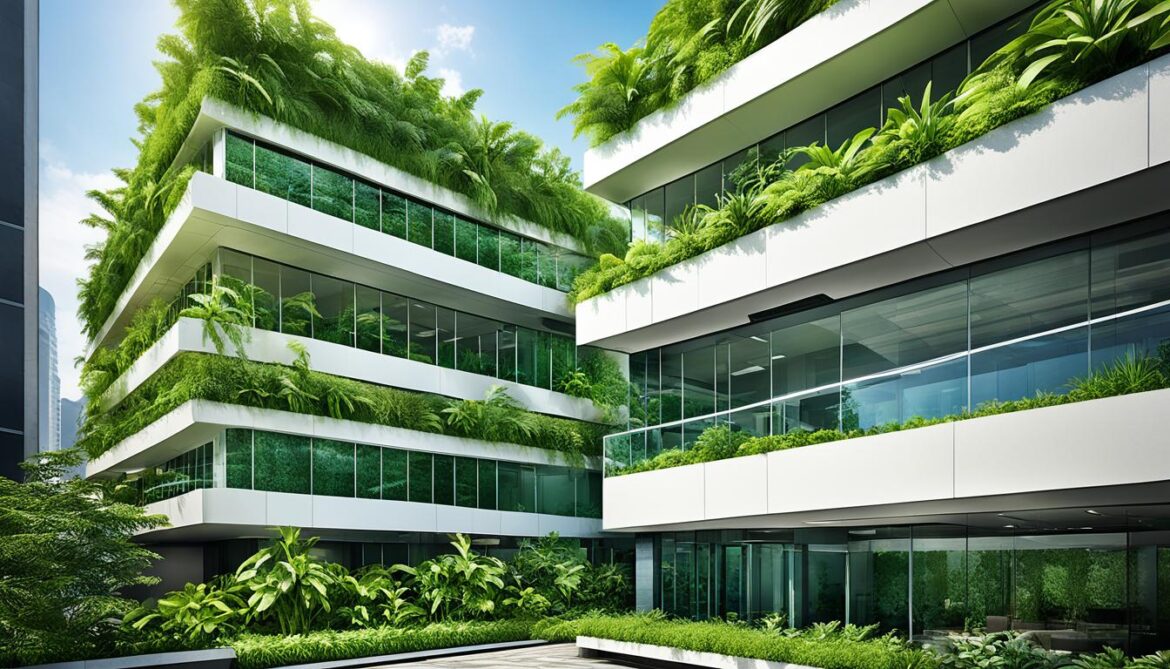
“Green building initiatives in Indonesia are paving the way for a more sustainable future, where energy efficiency and environmental responsibility are at the forefront of construction practices.”
Impact of Green Development in Indonesia
Green development in Indonesia has had a significant impact in reducing CO2 emissions and achieving energy savings, leading to impressive environmental benefits. Through the implementation of energy-efficient design and green construction practices, Indonesia has successfully reduced over 1 million metric tons of CO2 emissions and saved 1.5 million megawatt hours in energy use.
These sustainability efforts have not only contributed to a greener future but have also provided occupants with healthier and more comfortable living and working environments. Green buildings, constructed in adherence to green building standards, prioritize energy efficiency and sustainability, resulting in reduced environmental impact.
“The implementation of green building standards has not only improved sustainability but also provided healthier and more comfortable living and working environments for occupants.”
Although retrofitting existing buildings poses a challenge, the green building market in Indonesia shows great potential for growth. The adoption of green building practices is crucial in achieving long-term environmental sustainability and energy savings.
Below is a table summarizing the impact of green development in Indonesia:
| Environmental Benefit | Quantitative Impact |
|---|---|
| CO2 Emissions Reduction | Over 1 million metric tons |
| Energy Savings | 1.5 million megawatt hours |
Green Development and Environmental Benefits
The reduction of CO2 emissions and energy savings achieved through green development in Indonesia contribute to several environmental benefits. By prioritizing energy efficiency and sustainable construction practices, green buildings help combat climate change by reducing greenhouse gas emissions, particularly CO2. This reduction of CO2 emissions helps mitigate the impact of global warming and promotes a healthier environment for all.
In addition to CO2 emissions reduction, the implementation of green building standards allows for significant energy savings. Green buildings utilize energy-efficient systems and technologies that minimize energy consumption. This not only reduces the dependence on non-renewable energy sources but also contributes to substantial cost savings in the long run.
Moreover, green buildings promote environmental sustainability by conserving natural resources, such as water, through efficient water management systems. They also prioritize waste reduction and incorporate renewable energy sources, further enhancing their overall environmental performance.
The environmental benefits achieved through green development in Indonesia underline the importance of adopting sustainable practices and embracing green building initiatives.

Overall, green development in Indonesia has demonstrated its potential to create a more sustainable future. By continuing to prioritize energy efficiency, reduce CO2 emissions, and promote environmental sustainability, Indonesia can lead the way in building a greener and more environmentally conscious society.
Role of Green Building Council Indonesia
When it comes to promoting green building certification and establishing initiatives and standards for sustainable development, the Green Building Council Indonesia (GBCI) plays a crucial role. Through their renowned certification program, GREENSHIP, GBCI has certified over 25 million square meters of green buildings across Indonesia.
GBCI’s rating system provides comprehensive guidelines and criteria for sustainable design, construction, and operation. By setting sustainability standards and encouraging best practices, GBCI ensures that green buildings meet the highest environmental and performance standards, delivering long-term benefits for both occupants and the planet.
Supported by the government’s incentives and regulations, GBCI has successfully encouraged the widespread adoption of green building practices throughout the country. This collaboration has paved the way for a more environmentally conscious approach to construction and development in Indonesia.
With GBCI’s unwavering commitment to green building certification and their efforts in establishing sustainability standards, the organization continues to have a profound impact on the built environment. By recognizing and promoting environmentally friendly practices, GBCI is playing a significant role in driving Indonesia towards a more sustainable future.
Government Support for Green Building
The government of Indonesia is actively taking steps to promote green building development and support sustainable construction practices. Through the implementation of regulations, policies, and incentives, the government aims to create a greener and more environmentally conscious built environment in the country.
One of the key incentives provided by the government is tax benefits for green building projects. These tax benefits encourage developers to incorporate sustainable design and construction practices, making them more financially feasible and attractive. By offering these incentives, the government aims to level the playing field in the energy sector and promote the adoption of sustainable construction methods.
In addition to tax benefits, the government has also streamlined the permitting process for green building projects. Expedited permitting ensures that sustainable construction projects can proceed without unnecessary delays, facilitating the implementation of environmentally friendly practices.
Access to financing options specifically tailored to green building projects is another area where the government is providing support. By making financing readily available for developers and investors interested in sustainable construction, the government is removing financial barriers and encouraging private sector participation in green building initiatives.
Overall, the government’s commitment to supporting green building through incentives, regulations, and streamlined processes is commendable. By promoting sustainable construction practices, Indonesia can contribute to mitigating climate change, reducing carbon emissions, and creating a more sustainable future for the built environment.
Benefits of Green Building Certification
Green building certification plays a vital role in promoting sustainability and offers numerous benefits. When buildings are certified as green, they are designed and constructed with a strong focus on energy efficiency, water conservation, and improved indoor air quality.
One significant advantage of green buildings is their contribution to the reduction of CO2 emissions. By utilizing energy-efficient technologies and renewable energy sources, these buildings help combat climate change and promote environmental sustainability. The reduced CO2 emissions have a positive impact on the overall carbon footprint and contribute to a healthier planet.
Furthermore, green buildings conserve natural resources by incorporating sustainable materials and efficient water management systems. By reducing water consumption and adopting recycling practices, these buildings contribute to water conservation and help preserve this precious resource for future generations.
A notable benefit of green building certification is the provision of healthier living and working environments. By prioritizing indoor air quality, green buildings utilize low-VOC (volatile organic compounds) materials and efficient ventilation systems to create spaces that promote occupant health and well-being. Improved air quality within these buildings can lead to higher productivity, reduced instances of respiratory issues, and an overall higher quality of life for occupants.
In addition to the environmental and health benefits, green building practices foster innovation, job creation, and economic growth in the construction sector. The growing demand for sustainable buildings creates new opportunities for skilled professionals and encourages the adoption of advanced technologies and practices that drive the construction industry forward.
Green building certification not only benefits the environment but also provides a positive economic impact and enhances the overall quality of life for occupants. The integration of energy efficiency, environmental sustainability, and reduced CO2 emissions promotes a greener and more sustainable future in the built environment.
The Green Building Certification Process
The process of achieving green building certification involves a rigorous evaluation of various aspects, including energy efficiency, water conservation, site selection, and indoor environmental quality. Various certification programs, such as LEED (Leadership in Energy and Environmental Design) and BREEAM (Building Research Establishment Environmental Assessment Method), offer guidelines and criteria for builders and developers to meet sustainable design and construction standards.
Once a building satisfies the requirements of the certification program, it receives official recognition as a green building. This certification not only validates the environmental performance and sustainability of the building but also enhances its market value and credibility.
Through green building certification, environmentally conscious construction practices are encouraged and acknowledged, driving the industry towards a more sustainable future.
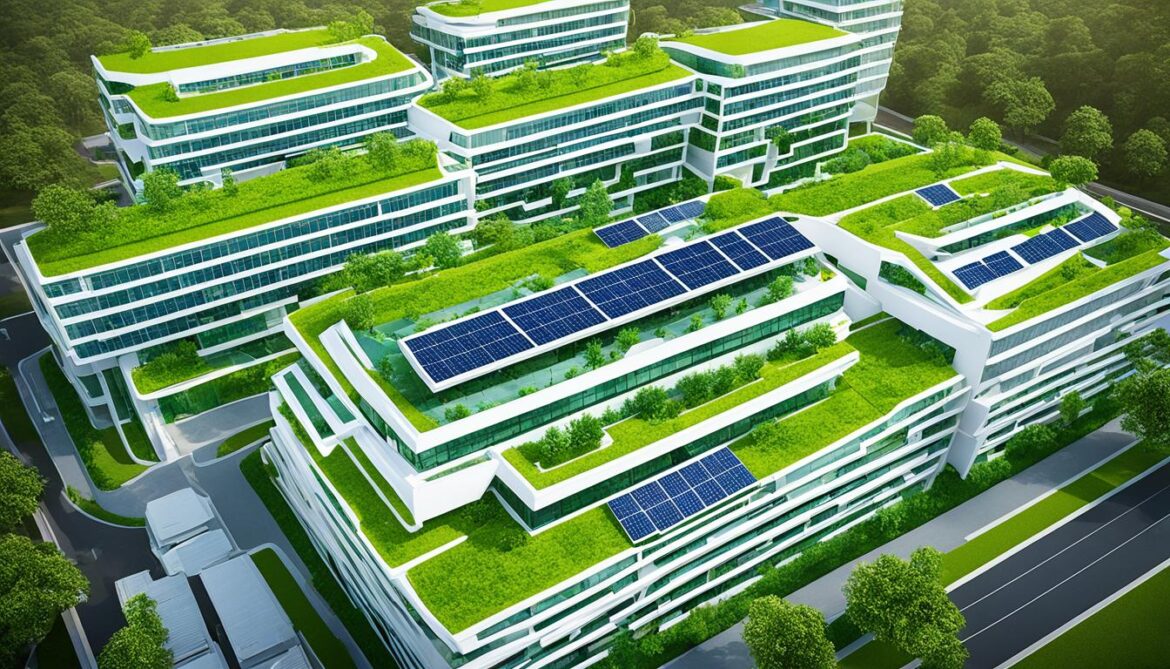
| Benefits of Green Building Certification | Key Points |
|---|---|
| Reduction of CO2 emissions | – Green buildings contribute to the reduction of CO2 emissions, leading to a healthier planet. |
| Conservation of natural resources | – Green buildings utilize sustainable materials and efficient water management systems to conserve natural resources. |
| Improved indoor air quality | – Green buildings prioritize occupant health by promoting better indoor air quality through the use of low-VOC materials and efficient ventilation systems. |
| Job creation and economic growth | – The demand for green buildings creates new job opportunities and drives economic growth in the construction sector. |
Conclusion
Indonesia’s biodiversity and the built environment face complex challenges, but efforts are being made to achieve a balance between conservation and urban development. Conservation initiatives, habitat restoration, and the incorporation of biodiversity-friendly design in urban planning play crucial roles in ensuring sustainable futures. By prioritizing biodiversity conservation and environmental responsibility, Indonesia can pave the way for a greener and more sustainable future in the built environment.
Green building initiatives also contribute significantly to environmental sustainability and energy efficiency. Through the implementation of green building practices, Indonesia has seen a reduction of over 1 million metric tons of CO2 emissions and significant energy savings, creating a more environmentally friendly built environment. The government’s support and organizations like the Green Building Council Indonesia play instrumental roles in promoting and recognizing sustainable construction practices across the country.
By continuing to prioritize conservation, sustainable development, and green building initiatives, Indonesia can address the challenges it faces and create a harmonious relationship between urban development and biodiversity protection. With the dedication of government, organizations, and individuals, Indonesia can build a greener and more sustainable future for the benefit of both its people and its rich natural heritage.




